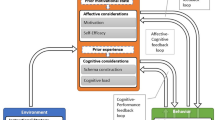Abstract
One of the canons that guides the design of microcomputer-based instructional programs is to use a self-paced instructional method. However, there has been some indication that moderate levels of external pacing may prove to be more effective for overall learning, in terms of amount of content acquired and level of competency achieved with that content. Hypotheses derived from this idea were tested using three types of pacing. Learning was evaluated using five achievement tests ranging in difficulty from memorizing facts to problem solving. Experimental results supported the hypothesis favoring moderate levels of external pacing and found that the common principle of using self-paced instructional methods as the best style for all types of microcomputer instruction is an incorrect assumption.
Similar content being viewed by others
References
Atkinson, R. C. (1968). Computerized instruction and the learning process.American Psychology, 23, 225–239.
Block, J. H. (1971).Mastery learning: Theory and practice. New York: Holt, Rinehart, Winston.
Carrier, C. (1984). Do learners make good choices?Instructional Innovator, 29(2), 15–17.
Carroll, J. B. (1963). A model of school learning.Teachers College Board, 64, 723–733.
Cross, P. K. (1976).Accent on learning. San Francisco, CA: Jossey-Bass.
Cronbach, L. J. (1967). How can instruction be adapted to individual differences? In R. M. Gagne (Ed.)Learning and individual differences (pp. 23–29). Columbus, OH: Merrill.
Cronbach, L. J., & Snow, R. E. (1969).Individual differences in learning ability as a function of instructional variables. Stanford, CA: Stanford School of Education.
DeCecco, J. P. (1963).Human learning in the school. New York: Holt, Rinehart, Winston.
Dwyer, F. M. Jr. (1967). A study of the relative effectiveness of varied visual illustration (Project #6-8840, Grant #OEG-107-068840-0290). Washington, D.C.: U.S. Department of Health, Education, and Welfare.
Glaser, R. (1968). Adapting the elementary school curriculum to individual performance.Proceedings of the 1967 Invitational Conference on Testing Problems. Princeton, NJ: Educational Testing Service, 3–36.
Gropper, G. L. (1964). The influence of external pacing on learning from programmed instruction (Report 2), InStudies in televised instruction, individualizing group instruction. Pittsburgh, PA: American Institute for Research in Behavioral Sciences.
Hunt, D. E. (1973, August). Person-environment interaction: A challenge found wanting before it was tried. Invited address for the American Psychological Association, Montreal, Quebec.
Kagan, J., Moss, H. A., & Sigel, I. E. (1963). Psychological significance of styles of conceptualization. In J. C. Wright and J. Kagan (Eds.).Basic cognitive progresses in children. New York: Society for Research in Child Development.
Keller, F. S. (1974). The basic system. In F. S. Keller and J. G. Sherman (Eds.)PSI-the Keller plan handbook: Essays on a personalized system of instruction. Menlo Park, CA: W. A. Benjamin.
Postlethwait, S. N. (1974). Minicourses: A concern for individualization.Proceedings of the National Conference on Open Learning in Higher Education, Lincoln, NE: State University of Nebraska.
Reiser, R. A. (1984). Reducing student procrastination in a personalized system of instruction course,Educational Communications Technology Journal, 32, 41–49.
Skinner, B. F. (1958). Teaching machines,Science, 128, 969–977.
Travers, R. M. W. (1972).Essentials of learning. New York: MacMillan.
Wittrock, M. C. (1979). The Cognitive movement in instruction,Educational Researcher, 8, 5–11.
Author information
Authors and Affiliations
Rights and permissions
About this article
Cite this article
Belland, J.C., Taylor, W.D., Canelos, J. et al. Is the self-paced instructional program, via microcomputer-based instruction, the most effective method of addressing individual learning differences?. ECTJ 33, 185–198 (1985). https://doi.org/10.1007/BF02769159
Issue Date:
DOI: https://doi.org/10.1007/BF02769159




